Glen Allen Office
(804) 747-3380
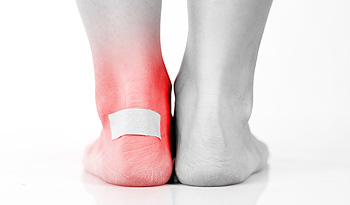 Blisters form when the skin raises into a bubble and becomes filled with fluid. Blisters can form anywhere on the foot where the foot and shoe rub together and cause irritation and friction. However, the most common blisters occur on the sides of the foot or on the back of the heel. Blisters can form due to excess friction caused by any repetitive motion, therefore having properly fitted shoes, and shoes designed for your activities, are key to preventing blisters. If you find that you are frequently experiencing blisters, it is important that you consult with a podiatrist about your treatment options, such as shoe inserts.
Blisters form when the skin raises into a bubble and becomes filled with fluid. Blisters can form anywhere on the foot where the foot and shoe rub together and cause irritation and friction. However, the most common blisters occur on the sides of the foot or on the back of the heel. Blisters can form due to excess friction caused by any repetitive motion, therefore having properly fitted shoes, and shoes designed for your activities, are key to preventing blisters. If you find that you are frequently experiencing blisters, it is important that you consult with a podiatrist about your treatment options, such as shoe inserts.
Blisters may appear as a single bubble or in a cluster. They can cause a lot of pain and may be filled with pus, blood, or watery serum. If your feet are hurting, contact one of our podiatrists of The Podiatry Center. Our doctors can provide the care you need to keep you pain-free and on your feet.
Foot Blisters
Foot blisters are often the result of friction. This happens due to the constant rubbing from shoes, which can lead to pain.
What Are Foot Blisters?
A foot blister is a small fluid-filled pocket that forms on the upper-most layer of the skin. Blisters are filled with clear fluid and can lead to blood drainage or pus if the area becomes infected.
Symptoms
(Blister symptoms may vary depending on what is causing them)
Prevention & Treatment
In order to prevent blisters, you should be sure to wear comfortable shoes with socks that cushion your feet and absorb sweat. Breaking a blister open may increase your chances of developing an infection. However, if your blister breaks, you should wash the area with soap and water immediately and then apply a bandage to the affected area. If your blisters cause severe pain it is important that you call your podiatrist right away.
If you have any questions, please feel free to contact one of our offices located in Richmond and Glen Allen, VA . We offer the newest diagnostic and treatment technologies for all your foot care needs.
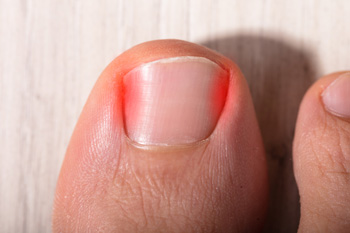 The condition that is known as an ingrown toenail can happen as a result of stubbing your toe. It may cause the nail to grow into the surrounding skin, which can cause pain and discomfort. Additional reasons this ailment can happen include trimming the toenails incorrectly, or wearing shoes that are too snug. Patients have found mild relief when the nail is soaked in warm water, as this may help to soften the edges of the nail. If you have an ingrown toenail, it is strongly suggested that you consult with a podiatrist who can treat the nail before it becomes infected, and offer you correct treatment remedies.
The condition that is known as an ingrown toenail can happen as a result of stubbing your toe. It may cause the nail to grow into the surrounding skin, which can cause pain and discomfort. Additional reasons this ailment can happen include trimming the toenails incorrectly, or wearing shoes that are too snug. Patients have found mild relief when the nail is soaked in warm water, as this may help to soften the edges of the nail. If you have an ingrown toenail, it is strongly suggested that you consult with a podiatrist who can treat the nail before it becomes infected, and offer you correct treatment remedies.
Ingrown toenails may initially present themselves as a minor discomfort, but they may progress into an infection in the skin without proper treatment. For more information about ingrown toenails, contact one of our podiatrists of The Podiatry Center. Our doctors can provide the care you need to keep you pain-free and on your feet.
Ingrown Toenails
Ingrown toenails are caused when the corner or side of a toenail grows into the soft flesh surrounding it. They often result in redness, swelling, pain, and in some cases, infection. This condition typically affects the big toe and may recur if it is not treated properly.
Causes
You are more likely to develop an ingrown toenail if you are obese, have diabetes, arthritis, or have any fungal infection in your nails. Additionally, people who have foot or toe deformities are at a higher risk of developing an ingrown toenail.
Symptoms
Some symptoms of ingrown toenails are redness, swelling, and pain. In rare cases, there may be a yellowish drainage coming from the nail.
Treatment
Ignoring an ingrown toenail can have serious complications. Infections of the nail border can progress to a deeper soft-tissue infection, which can then turn into a bone infection. You should always speak with your podiatrist if you suspect you have an ingrown toenail, especially if you have diabetes or poor circulation.
If you have any questions, please feel free to contact one of our offices located in Richmond and Glen Allen, VA . We offer the newest diagnostic and treatment technologies for all your foot care needs.
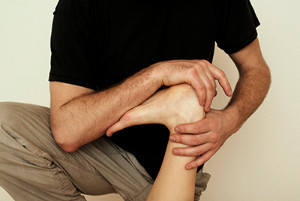 Many people who enjoy running are aware of the importance of stretching their feet. The pain that is felt from the foot condition that is known as plantar fasciitis generally occurs as a result of repetitive use. Research has indicated there are specific stretches that can be performed for the plantar fascia. These can include towel stretches, and certain massage techniques. Additionally, this part of the foot can be stretched by rolling the bottom of the foot on a tennis ball. Flexibility may be increased when the calf muscles are lengthened. This is implemented by facing a wall while standing, and gently stretching one leg at a time. If you would like more information about the benefits of stretching the feet, please consult with a podiatrist.
Many people who enjoy running are aware of the importance of stretching their feet. The pain that is felt from the foot condition that is known as plantar fasciitis generally occurs as a result of repetitive use. Research has indicated there are specific stretches that can be performed for the plantar fascia. These can include towel stretches, and certain massage techniques. Additionally, this part of the foot can be stretched by rolling the bottom of the foot on a tennis ball. Flexibility may be increased when the calf muscles are lengthened. This is implemented by facing a wall while standing, and gently stretching one leg at a time. If you would like more information about the benefits of stretching the feet, please consult with a podiatrist.
Stretching the feet is a great way to prevent injuries. If you have any concerns with your feet consult with one of our podiatrists from The Podiatry Center. Our doctors will assess your condition and provide you with quality foot and ankle treatment.
Stretching the Feet
Being the backbone of the body, the feet carry your entire weight and can easily become overexerted, causing cramps and pain. As with any body part, stretching your feet can serve many benefits. From increasing flexibility to even providing some pain relief, be sure to give your feet a stretch from time to time. This is especially important for athletes or anyone performing aerobic exercises, but anyone experiencing foot pain or is on their feet constantly should also engage in this practice.
Great ways to stretch your feet:
Individuals who tend to their feet by regular stretching every day should be able to minimize foot pain and prevent new problems from arising.
If you have any questions, please feel free to contact one of our offices located in Richmond and Glen Allen, VA . We offer the newest diagnostic and treatment technologies for all your foot care needs.
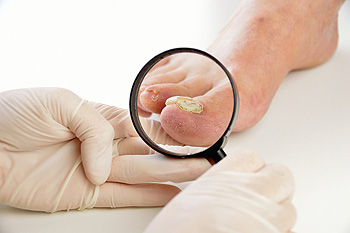 Fungal toenails, while often unsightly, can also be extremely uncomfortable. They can be identified by discoloration and thickening of the toenail. In some cases the nail may become so brittle that it breaks or splits, causing a great deal of pain. Fungal toenails can be more common among people who are diabetic, have a poor immune system, lack personal hygiene, and those who do not wear proper footwear in high risk fungal contaminated environments. Some of these environments can include public swimming pools, gyms, locker rooms, and communal showers. The fungi can enter through an opening in the nail, causing the infection. If left untreated, it may spread, creating more serious foot complications. For more advice on how to treat this condition, it is suggested that you seek professional care from a podiatrist.
Fungal toenails, while often unsightly, can also be extremely uncomfortable. They can be identified by discoloration and thickening of the toenail. In some cases the nail may become so brittle that it breaks or splits, causing a great deal of pain. Fungal toenails can be more common among people who are diabetic, have a poor immune system, lack personal hygiene, and those who do not wear proper footwear in high risk fungal contaminated environments. Some of these environments can include public swimming pools, gyms, locker rooms, and communal showers. The fungi can enter through an opening in the nail, causing the infection. If left untreated, it may spread, creating more serious foot complications. For more advice on how to treat this condition, it is suggested that you seek professional care from a podiatrist.
If left untreated, toenail fungus may spread to other toenails, skin, or even fingernails. If you suspect you have toenail fungus it is important to seek treatment right away. For more information about treatment, contact one of our podiatrists of The Podiatry Center. Our doctors can provide the care you need to keep you pain-free and on your feet.
Symptoms
Treatment
If self-care strategies and over-the-counter medications does not help your fungus, your podiatrist may give you a prescription drug instead. Even if you find relief from your toenail fungus symptoms, you may experience a repeat infection in the future.
Prevention
In order to prevent getting toenail fungus in the future, you should always make sure to wash your feet with soap and water. After washing, it is important to dry your feet thoroughly especially in between the toes. When trimming your toenails, be sure to trim straight across instead of in a rounded shape. It is crucial not to cover up discolored nails with nail polish because that will prevent your nail from being able to “breathe”.
In some cases, surgical procedure may be needed to remove the toenail fungus. Consult with your podiatrist about the best treatment options for your case of toenail fungus.
If you have any questions, please feel free to contact one of our offices located in Richmond and Glen Allen, VA . We offer the newest diagnostic and treatment technologies for all your foot care needs.
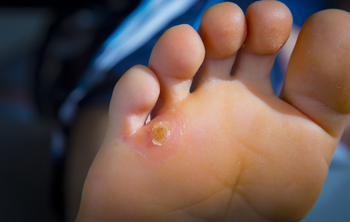 A corn can cause severe discomfort while wearing shoes. There are two types of corns that can develop on the feet. Soft corns are generally found between the toes, and can occur from wearing shoes that do not have adequate room for the toes to move freely in. Hard corns are located on the sole of the foot, or on top of the toes, and can develop from excessive friction. Mild relief may be found when a protective pad is placed over the corn, and it is beneficial to wear shoes that fit correctly. Corns on the feet can cause your walking style to be altered, which naturally compensates for the pain and discomfort that is associated with corns. If you are afflicted with a corn on your foot, please consult with a podiatrist who can offer correct treatment techniques.
A corn can cause severe discomfort while wearing shoes. There are two types of corns that can develop on the feet. Soft corns are generally found between the toes, and can occur from wearing shoes that do not have adequate room for the toes to move freely in. Hard corns are located on the sole of the foot, or on top of the toes, and can develop from excessive friction. Mild relief may be found when a protective pad is placed over the corn, and it is beneficial to wear shoes that fit correctly. Corns on the feet can cause your walking style to be altered, which naturally compensates for the pain and discomfort that is associated with corns. If you are afflicted with a corn on your foot, please consult with a podiatrist who can offer correct treatment techniques.
Corns can make walking very painful and should be treated immediately. If you have questions regarding your feet and ankles, contact one of our podiatrists of The Podiatry Center. Our doctors will treat your foot and ankle needs.
Corns: What Are They? And How Do You Get Rid of Them?
Corns are thickened areas on the skin that can become painful. They are caused by excessive pressure and friction on the skin. Corns press into the deeper layers of the skin and are usually round in shape.
Ways to Prevent Corns
There are many ways to get rid of painful corns such as:
Treating Corns
Although most corns slowly disappear when the friction or pressure stops, this isn’t always the case. Consult with your podiatrist to determine the best treatment option for your case of corns.
If you have any questions please feel free to contact one of our offices located in Richmond and Glen Allen, VA . We offer the newest diagnostic and treatment technologies for all your foot and ankle needs.